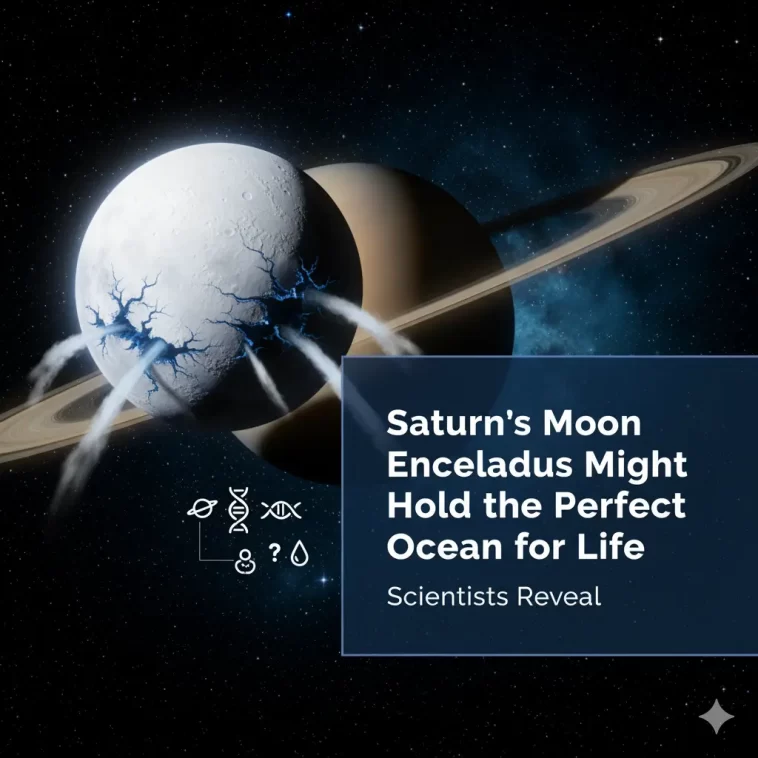A New Chapter in the Search for Life
Saturn’s icy moon Enceladus has long been one of the most mysterious objects in our Solar System. Now, new scientific findings have reignited hope that it could actually harbor life beneath its frozen shell.
According to newly reexamined data from NASA’s retired Cassini spacecraft, Enceladus is leaking a steady stream of heat from its North Pole, suggesting that the massive subsurface ocean beneath its icy crust is far more stable and life-friendly than previously thought.
Scientists believe this balance could create the ideal conditions for life to evolve and thrive, marking a major turning point in humanity’s search for extraterrestrial organisms.
A Hidden Ocean Beneath the Ice
Although Enceladus’ surface temperatures can plummet to a bone-chilling –201°C, beneath that frozen shell lies an ocean rich in the chemical ingredients of life — including water, carbon, hydrogen, and nitrogen.
What researchers couldn’t confirm until now was whether this ocean could remain stable long enough for life to form.
Dr. Carly Howett from Oxford University, a co-author of the study, explained the significance of the discovery:
“Life needs stability to survive. Showing that Enceladus’s energy output has remained consistent implies that its internal environment is also remarkably stable — a key requirement for habitability.”
How Enceladus Stays Warm in the Cold Depths of Space
With a diameter of just 500 kilometers, Enceladus is constantly being squeezed and stretched by Saturn’s immense gravitational pull — a process known as tidal heating.
This internal friction generates energy that prevents the moon from freezing completely. But for life to persist, that energy must remain in perfect balance:
- If Enceladus loses too much heat, the ocean would freeze solid — a death sentence for any chance of life.
- If it produces too much heat, the ocean could become unstable, rapidly changing in temperature and chemistry, making survival impossible.
The latest analysis suggests the moon has achieved a rare thermal equilibrium, maintaining just the right amount of energy to sustain its hidden sea.
Cracking the Code of the “Tiger Stripes”
Previous studies focused on the famous “tiger stripes” — long fractures near Enceladus’s South Pole that spew massive plumes of water vapor and ice into space.
These geysers hinted at intense activity below the surface, but calculating the total energy loss across the entire moon remained difficult.
Using temperature data from Cassini, researchers compared readings from Enceladus’s North Pole during its winter and summer cycles. Surprisingly, the northern surface was found to be about 7°C warmer than expected.
This subtle temperature rise revealed that Enceladus is losing about 46 milliwatts per square meter, equivalent to 35 gigawatts globally — roughly matching the energy input from tidal heating.
When combined with the energy escaping from the active southern regions, the total loss reaches 54 gigawatts, proving that Enceladus’s energy system is in near-perfect balance.
“That balance suggests Enceladus’s ocean is both long-lived and stable — exactly the type of environment where life could emerge,” said Dr. Howett.
Could Life Already Exist There?
Scientists aren’t sure what life on Enceladus might look like. It could resemble the shrimp, crabs, and microbes found around Earth’s deep-sea hydrothermal vents, thriving without sunlight and feeding on chemical energy.
Others believe Enceladus might host entirely alien life forms, evolved to survive in environments far harsher than anything on Earth.
The balance of heat and chemistry detected on the moon means that liquid water has likely persisted for millions — if not billions — of years, giving life ample time to develop.
What Comes Next for Space Exploration
The next step for scientists is to determine how long Enceladus’s ocean has existed and whether it has remained stable long enough for life to form.
If so, future missions may target the icy plumes erupting from the South Pole, which could contain organic molecules or biosignatures from the ocean below.
NASA has already discussed concepts for a dedicated Enceladus probe, possibly capable of flying through the water jets or even drilling through the ice to directly sample the ocean.
Such a mission could provide definitive evidence of extraterrestrial life — a discovery that would completely reshape our understanding of biology and the origins of life in the universe.
The Bigger Picture: Why Enceladus Matters
While Mars has long dominated the headlines in the search for life, icy moons like Enceladus and Jupiter’s Europa may hold the real answers.
These frozen worlds hide vast oceans beneath their surfaces — oceans that might be more stable and life-supporting than any found on the Red Planet.
Enceladus, with its delicate energy balance and proven water chemistry, could be the closest thing to a second cradle of life within our Solar System.
As Dr. Howett put it:
“If life can find a way to survive on Enceladus, it means that life could be common across the cosmos.”
Conclusion: The Door to a New Era of Discovery
This new research doesn’t just deepen our understanding of one icy moon — it opens the door to a new chapter in astrobiology.
Saturn’s moon Enceladus reminds us that even in the coldest, darkest corners of space, the spark of life may still exist — quietly waiting beneath layers of ancient ice.
The next time we look up at Saturn through a telescope, we might just be gazing at the most promising alien ocean in our Solar System.

